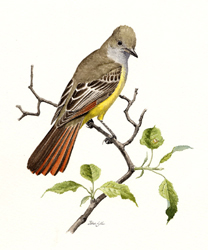Find a Bird - BBA1
Breeding Bird Atlas 1 Species Accounts
Great Crested Flycatcher
Myiarchus crinitus
Egg Dates
May 28 to June 26
Number of Broods
one

At the turn of the century, the Great Crested Flycatcher was an uncommon to rare local summer resident. This is not surprising because this flycatcher is a bird of the forest, and much of Massachusetts was open farmland in the nineteenth century. Agriculture went into a serious decline in the mid-1800s, at which time forest cover once again became a dominant feature of the landscape. As a result, the Great Crested Flycatcher is now a fairly common breeding bird throughout the state wherever deciduous woodlands occur. It is less common on Cape Cod and the Islands and in the higher elevations of the state where coniferous woodlands predominate.
Early individuals are usually seen in late April, but it is not until early May that a widespread arrival is noticed. Migrants pass through until late May, by which time residents have established their territories. The Great Crested Flycatcher is very vocal, emitting a loud, drawn-out wheep from an exposed perch in the woods. Often this call is abbreviated and uttered in rapid succession, possibly a sign of agitation. During courtship, the male actively pursues the female.
The Great Crested Flycatcher is unique among Massachusetts flycatchers in that it builds its nest in a hole, either a natural cavity, an old woodpecker hole, or even a nest box. Old records of nests from southeastern Massachusetts indicate that nearly all were found in orchards in cavities in the trunk or main branches of apple trees from 6 to 11 feet in height. One, located in a dead stub in swampy woods, was open at the top and 7 feet aboveground (ACB). More recent records include 6 in nest boxes in mixed forest from 6 to 14 feet (CNR); 1 in an open-ended, hollow, horizontal branch of a Black Cherry at 10 feet (Meservey); 1 at 25 feet in an old woodpecker hole in a dead oak (Meservey). The cavity, which may be 2 to 3 feet deep, is filled with old leaves, bark, and grasses, with a cuplike hollow fashioned near the top. A curious aspect of this structure, and one that is surrounded by much folklore, is that it frequently contains a shed snakeskin. One wonders whether the snakeskin benefits are transferable to the cellophane strips that now often appear in the nest. As much as two weeks may be required to complete the nest.
The female incubates the five or six eggs (range four to eight) for about two weeks. The clutch sizes in 4 Massachusetts nests were 1 set each of four and five eggs and 2 sets of six eggs (ACB, CNR, DKW). Both parents share in feeding the young, which fledge in 12 to 18 days. Nests containing two to five (average 3.5) young have been recorded in Massachusetts from June 19 to July 17, and fledglings have been reported from July 6 to July 21 (CNR).
Great Crested Flycatchers defend large territories, and adults are extremely aggressive in the immediate vicinity of the nest. Once the young have fledged, Great Crested Flycatchers become inconspicuous as they feed primarily in the canopy. The only evidence of their presence is their occasional loud distinctive call. Fall migration commences in late August, and most have departed our area by the end of September. Seldom do you see more than one at a time on migration. The species winters from southern Florida south to northern South America.
There are a number of records for this species in October, November, and December. Several of these were indeed Great Crested Flycatchers, as shown by at least one specimen and several meticulously described sight observations. However, there have been several recent valid records for the Ash-throated Flycatcher (Myiarchus cinerascens), mostly in November or December. Therefore, any unseasonable Myiarchus should be closely scrutinized.
Map Legend and Data Summary
Atlas 1 data collected from 1975-1979


Note: uncommon to fairly common in forested areas throughout the state
Richard A. Forster



